With notes from “The Mystery of Faith” by Lawrence J
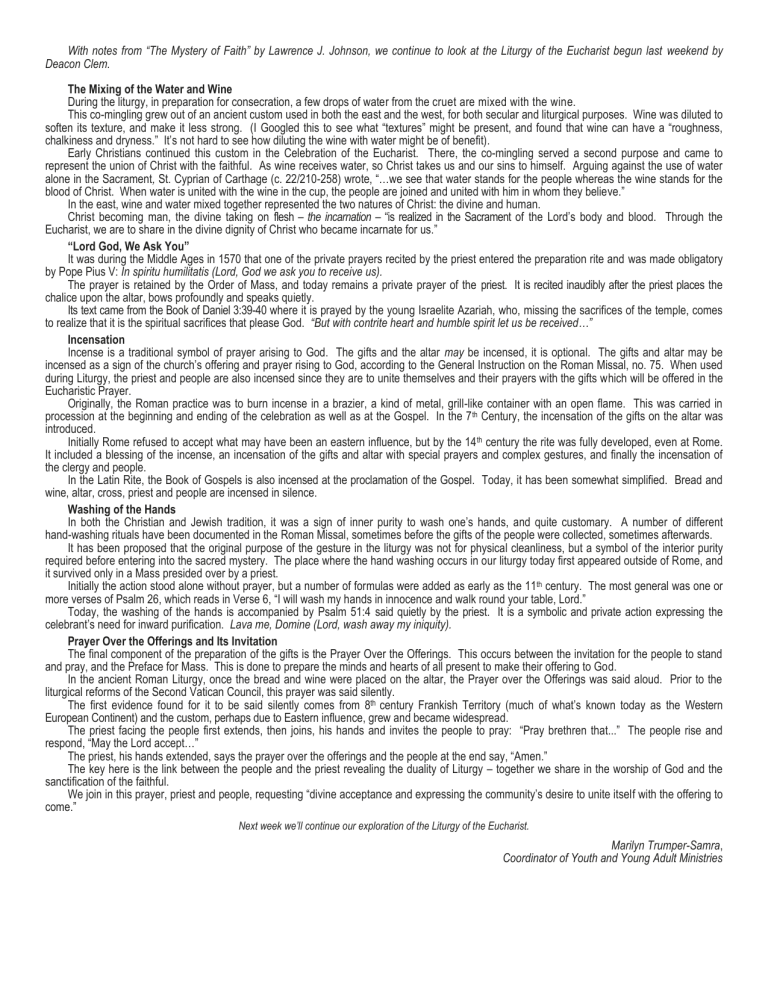
With notes from “The Mystery of Faith” by Lawrence J. Johnson, we continue to look at the Liturgy of the Eucharist begun last weekend by
Deacon Clem.
The Mixing of the Water and Wine
During the liturgy, in preparation for consecration, a few drops of water from the cruet are mixed with the wine.
This co-mingling grew out of an ancient custom used in both the east and the west, for both secular and liturgical purposes. Wine was diluted to soften its texture, and make it less strong. (I Googled this to see what “textures” might be present, and found that wine can have a “roughness, chalkiness and dryness.” It’s not hard to see how diluting the wine with water might be of benefit).
Early Christians continued this custom in the Celebration of the Eucharist. There, the co-mingling served a second purpose and came to represent the union of Christ with the faithful. As wine receives water, so Christ takes us and our sins to himself. Arguing against the use of water alone in the Sacrament, St. Cyprian of Carthage (c. 22/210-258) wrote, “…we see that water stands for the people whereas the wine stands for the blood of Christ. When water is united with the wine in the cup, the people are joined and united with him in whom they believe.”
In the east, wine and water mixed together represented the two natures of Christ: the divine and human.
Christ becoming man, the divine taking on flesh – the incarnation – “is realized in the Sacrament of the Lord’s body and blood. Through the
Eucharist, we are to share in the divine dignity of Christ who became incarnate for us.”
“Lord God, We Ask You”
It was during the Middle Ages in 1570 that one of the private prayers recited by the priest entered the preparation rite and was made obligatory by Pope Pius V: In spiritu humilitatis (Lord, God we ask you to receive us).
The prayer is retained by the Order of Mass, and today remains a private prayer of the priest. It is recited inaudibly after the priest places the chalice upon the altar, bows profoundly and speaks quietly.
Its text came from the Book of Daniel 3:39-40 where it is prayed by the young Israelite Azariah, who, missing the sacrifices of the temple, comes to realize that it is the spiritual sacrifices that please God. “But with contrite heart and humble spirit let us be received…”
Incensation
Incense is a traditional symbol of prayer arising to God. The gifts and the altar may be incensed, it is optional. The gifts and altar may be incensed as a sign of the church’s offering and prayer rising to God, according to the General Instruction on the Roman Missal, no. 75. When used during Liturgy, the priest and people are also incensed since they are to unite themselves and their prayers with the gifts which will be offered in the
Eucharistic Prayer.
Originally, the Roman practice was to burn incense in a brazier, a kind of metal, grill-like container with an open flame. This was carried in procession at the beginning and ending of the celebration as well as at the Gospel. In the 7 th Century, the incensation of the gifts on the altar was introduced.
Initially Rome refused to accept what may have been an eastern influence, but by the 14 th century the rite was fully developed, even at Rome.
It included a blessing of the incense, an incensation of the gifts and altar with special prayers and complex gestures, and finally the incensation of the clergy and people.
In the Latin Rite, the Book of Gospels is also incensed at the proclamation of the Gospel. Today, it has been somewhat simplified. Bread and wine, altar, cross, priest and people are incensed in silence.
Washing of the Hands
In both the Christian and Jewish tradition, it was a sign of inner purity to wash one’s hands, and quite customary. A number of different hand-washing rituals have been documented in the Roman Missal, sometimes before the gifts of the people were collected, sometimes afterwards.
It has been proposed that the original purpose of the gesture in the liturgy was not for physical cleanliness, but a symbol of the interior purity required before entering into the sacred mystery. The place where the hand washing occurs in our liturgy today first appeared outside of Rome, and it survived only in a Mass presided over by a priest.
Initially the action stood alone without prayer, but a number of formulas were added as early as the 11 th century. The most general was one or more verses of Psalm 26, which reads in Verse 6, “I will wash my hands in innocence and walk round your table, Lord.”
Today, the washing of the hands is accompanied by Psalm 51:4 said quietly by the priest. It is a symbolic and private action expressing the celebrant’s need for inward purification. Lava me, Domine (Lord, wash away my iniquity).
Prayer Over the Offerings and Its Invitation
The final component of the preparation of the gifts is the Prayer Over the Offerings. This occurs between the invitation for the people to stand and pray, and the Preface for Mass. This is done to prepare the minds and hearts of all present to make their offering to God.
In the ancient Roman Liturgy, once the bread and wine were placed on the altar, the Prayer over the Offerings was said aloud. Prior to the liturgical reforms of the Second Vatican Council, this prayer was said silently.
The first evidence found for it to be said silently comes from 8 th century Frankish Territory (much of what’s known today as the Western
European Continent) and the custom, perhaps due to Eastern influence, grew and became widespread.
The priest facing the people first extends, then joins, his hands and invites the people to pray: “Pray brethren that...” The people rise and respond, “May the Lord accept…”
The priest, his hands extended, says the prayer over the offerings and the people at the end say, “Amen.”
The key here is the link between the people and the priest revealing the duality of Liturgy – together we share in the worship of God and the sanctification of the faithful.
We join in this prayer, priest and people, requesting “divine acceptance and expressing the community’s desire to unite itself with the offering to come.”
Next week we’ll continue our exploration of the Liturgy of the Eucharist.
Marilyn Trumper-Samra,
Coordinator of Youth and Young Adult Ministries
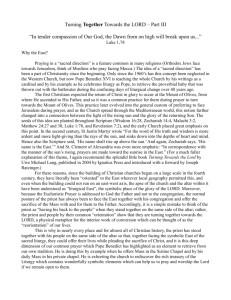
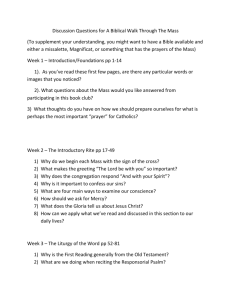
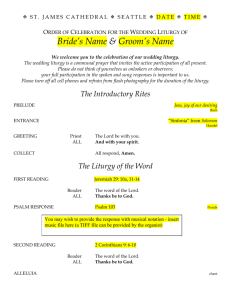
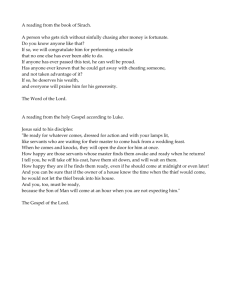
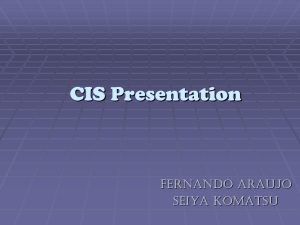

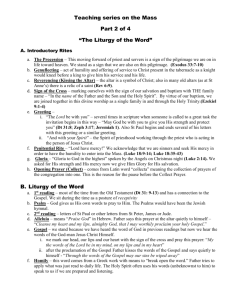
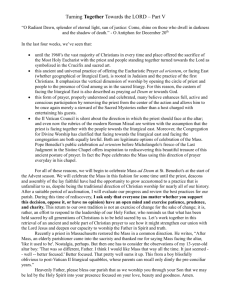
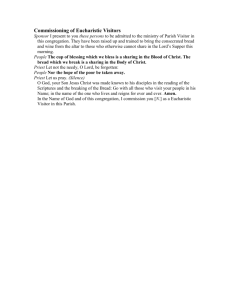
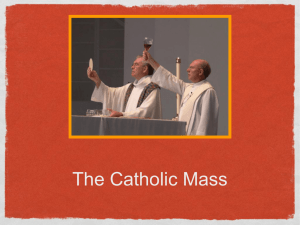
![10] ARTICLES ON THE EUCHARIST.doc](http://s3.studylib.net/store/data/008063614_1-5a52eaa67f9352a88e96e10749603082-300x300.png)